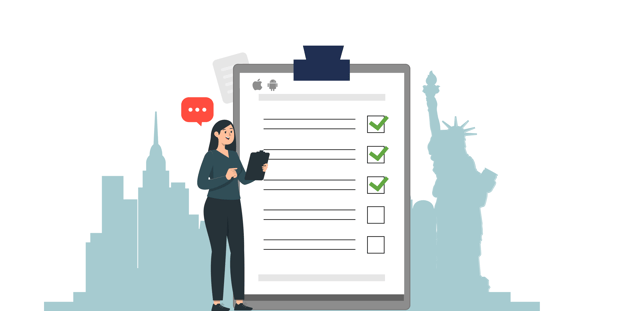
BLOG

BLOG
Over 4 million mobile apps (Android and iOS combined) are available to download. A majority of those apps store and process confidential user information such as contact number, email, age, gender, banking details, etc. No wonder mobile apps are one of the most lucrative and sought-after targets for hackers, and app fraud volumes are expected to double by 2026.
Keeping this in mind, FTC in or Federal Trade Commission in the USA has issued some guidelines for app developers to ensure data privacy and mobile app security. So, if you plan to launch a mobile app in the USA, you must follow those guidelines.
Below, we'll discuss some essential guidelines listed by the FTC and a technical security checklist you can implement to enhance your mobile app security. So, read in full.
An insecure mobile application invites the following consequences:
If your mobile application is not secure, it'll become an easy target for hackers. And this increases the likelihood of your app being involved in data breaches. As a result, you might lose confidential business data or customer information, which can be further used for illicit means.
As mentioned in the previous pointer, an insecure app becomes more likely to be involved in data breaches. However, if the news gets public, it can lead to reputational damage. Your customers might lose trust in your brand and switch to alternatives, which can plummet your revenue. And all this can give you a competitive disadvantage.
If your business or application is involved in a data breach or similar event, you may have to go through legal proceedings for not complying with the guidelines. Also, you may have to pay hefty fines. This not only takes up your resources but also trains the image of your company.
Apps with poorly secured source code are often easy to reverse engineer. The hackers can break into your app, analyze your code and exploit vulnerabilities. Also, they can bypass security and make your premium features available for free, impacting your revenue substantially.
Here's what the Financial Trade commission recommends to app developers:
FTC has also released some tips specifically for enhancing mobile app security, such as:
Please Note: Different states in the United States have different regulations concerning data and privacy. You can refer to them here.
One of the most common methods hackers use to gain unauthorized access is using brute force attacks. However, you can make your application more resilient to such attacks by enforcing a robust authentication such as 2-factor or multifactor authentication.
Using multifactor authentication, the user must use more than one method to validate their identity. For instance, there could be a passcode and an OTP or biometrics. This way, even if the hacker has the password, they cannot access the application as they cannot get the OTP or forge biometrics as easily.
DevOps is organizations' most common methodology to ensure a speedy software development process. However, this methodology keeps security as an afterthought, making it hard to create completely secure apps.
Therefore, you must opt for DevSecOps, the security-first version of the DevOps methodology. In DevSecOps, security is integrated into every stage of the software development lifecycle. Also, security becomes the entire development team's collective responsibility, not just security testers. This helps identify and mitigate the issues early and helps ensure better app security.
While iOS apps are not immune to reverse engineering, the process is way more complex than Android apps. This is because Android is based on Linux, which is open-source in nature. However, reverse engineering can threaten companies more as hackers can access the source code, bypass security and replicate the code to create new apps.
So, make your app secure enough to avoid reverse engineering. While completely preventing reverse engineering may not be possible, you can always make it complicated by trying the following:
4) Continuous Penetration Testing and Vulnerability Assessment
Performing regular pen tests and vulnerability assessments is challenging and requires dedicated resources. However, these security procedures can enhance your mobile app security like nothing else. Here's how:
While penetration testing and vulnerability assessment solutions are effective, you'll need an industry expert and reliable tool to improve your app's security. And we got you covered.
Considering the following factors when looking for a pen tester in the US can help you make the right decision:
Here are some factors to consider when looking for a vulnerability assessment solution in the US:
With the above info at your disposal, you can easily choose the right pen tester and a vulnerability assessment tool to boost your mobile app security. However, if you don't have the time to research, you can rely on the below security experts:
Promatas can help you with both vulnerability assessment scans and penetration testing. You can leverage Promatas to test your networks, mobile apps, and even your web apps and make them more secure and resilient. In addition, using Promatas, you can comply with government regulations and other regulatory requirements to avoid any legal repercussions.
GuardSight is one of the most reliable and comprehensive vulnerability and penetration assessment solutions in the United States. Using GuardSight, you can conduct in-depth vulnerability assessments to identify weaknesses, vulnerabilities, and technical flaws and mitigate the same effectively.
Better mobile app security brings along numerous advantages. For instance, it creates a sense of trust among your customers, keeps their and your business data secure, saves you from reputational damage, prevents legal & financial repercussions, and gives you an edge over your competitors.
And the best part is that you can achieve all of the above just by following the security checklist. So, what are you waiting for? Include the above checklist in your SDLC and start making more resilient mobile applications.
.jpg?width=50&height=50&name=10606600_10204086667262761_7381430219125488912_n%20(1).jpg)